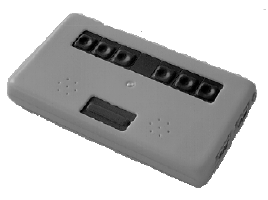

by Radim Matulík
Blind people have two main options how to access information either in audio or in a tactile form. Until recently, prerecorded magnetic tape and special tactile print (large, heavy and due to small quantity also expensive books) were the only ways to realize access, both rather clumsy. Even such a natural activity for most people as writing a note on paper, is, for blind people, connected with either the availability of a special typewriter or the necessity to press each letter point by point onto the paper.
Recent technology developments, such as synthetic voice, dynamic tactile display, computer typesetting, and the wide spread use of PCs, fortunately also offer new possibilities for work and studies for blind people. The development of microelectronics enabled the creation of a notetaker with a special keyboard for rapid note taking, and quick query of recorded notes in its memory, as well.
Equipped with synthetic speech, the notebook performs many tasks in several ways. It can serve as a notetaker. Users can make lists, search through them, remove or add items. They can ask for the time or date. In addition to accurate time, there are also stop watch, alarm clock and count-down timer functionalities. The telephone directory makes it possible to store names, phone numbers and addresses. The diary maintains users' appointments and reminders of important events.

Notebook for the blind, which can replace the traditional
notebook, offering functionality that supports note-taking, time, phone
directory and appointment operations.
The notebook can exchange information with a computer via an infrared port
or a cable. Hence, a user can work with the notebook anywhere, and later
transmit his or her work to a computer, or receive a large amount of information
(eg an entire book) from a net-connected computer and read the information
with the notebook whenever and wherever he or she likes.
Due to small (pocket) dimensions and build-in rechargeable battery, the user has an aid for instantaneous every-day use with him. In the near future, the connection to an external disk unit will make the user independent from the computer in accessing his library, placed on the disks.
Quick access to the information is the fundamental condition of rehabilitation of visually handicapped people and of their integration into society. The mentioned notebook holds out hopes for improving the quality of teaching at schools for visually handicapped people, creating new job opportunities and, last but not least, making their everyday life easier.
Please contact:
Radim Matulík - CRCIM-UTIA
Tel: +422 66052452
E-mail: matulik@utia.cas.cz